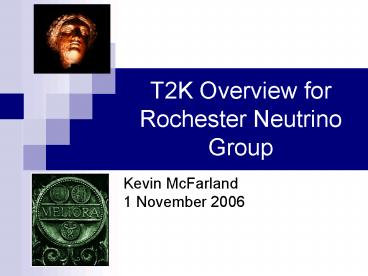T2K Overview for Rochester Neutrino Group - PowerPoint PPT Presentation
1 / 20
Title:
T2K Overview for Rochester Neutrino Group
Description:
T2K Overview for Rochester Neutrino Group. Kevin McFarland. 1 ... stationary; 'trundle table' s under 'bedframe' K. McFarland, Neutrino Group Overview ... – PowerPoint PPT presentation
Number of Views:50
Avg rating:3.0/5.0
Title: T2K Overview for Rochester Neutrino Group
1
T2K Overview for Rochester Neutrino Group
- Kevin McFarland1 November 2006
2
Neutrino OscillationsThe Big Picture
3
Status of Neutrino Oscillations
- Atmospheric (Super-K, K2K) andSolar (SNO,
KAMLAND) neutrinooscillation signatures are
wellestablished
sin22?gt 0.92 ?m2(1.6
3.9)10-3eV2
Super-K
4
Status of Neutrino Oscillations
- Atmospheric (Super-K, K2K) andSolar (SNO,
KAMLAND) neutrinooscillation signatures are
wellestablished
KAMLAND
SNO
5
Why Study Oscillations? Qualitative Questions
- The questions facing us now are fundamental, and
not simply a matter of measuring oscillations
better - Examples
- Are there more than three neutrinos?
- What is the hierarchy of masses?
- Can neutrinos contribute significantly to the
mass of the universe? - Is there CP violation in neutrino mixings?
6
Three Generation Mixing
- Note the new mixing in middle, and the phase, d
7
Are Two Paths Open to Us?
- If CHOOZ mixing, q13, is small, but not too
small, there is an interesting possibility - At atmospheric L/E,
8
Implication of two paths
- Two amplitudes
- If both small,but not too small,both can
contribute equally - Relative phase, d, between them can lead toCP
violation (neutrinos and anti-neutrinos differ)
in oscillations!
9
Importance of Precision P(nm?ne) at Superbeams
- Conventional superbeams and reactors will be
our next windows into q13, d
- Studying this transition in neutrinos and
anti-neutrinos gives us q and d as well as sign
of dm23 (mass hierarchy) - Reactors only measure q
- Comparing multiple precise measurements is
necessary
10
Our Groups Strategy
11
T2K
12
Basics of T2K
- Tunable off-axis beam from 0.8MW J-PARC source to
Super-K - beam and nm backgrounds are kept below 1 for ne
signal - 2200 nm events/yr (w/o osc.)
d0, no matter effects
13
The T2K 280m Detector
14
US Contribution to 280m Detector The P0D
- Active scintillator detector for 280m (near)
detector for p0 reconstruction (P0D) - Youll be shocked to learn it looks a lot like
MINERvA - We will work on parts (scintillator extrusions,
WLS fibers, optical connectors) weve already
worked on for MINERvA
white scintillator, mesh water, red lead
foil
15
T2K US B280 Proposal
- The T2K B280 (beamline and 280m detector)
submitted a proposal to DOE-HEP for construction - Also presented to NUSAG
- Have received FY06 RD funds for engineering and
component development - P0D modules (P0Dules, my bad) are a Colorado
State-Rochester-Stony Brook collaboration - The P0D is a 2.7M detector
- Construction will dovetail into end of MINERvA
- For Rochester, we want to keep factories going,
do only minimal RD specific to T2K (MINERvA
designs)
16
Our Piece of the P0D
17
Rochester P0D Responsibilities
- Scintillator
- this means little except negotiating with the lab
to produce scintillator. We will handle ordering
of materials and shipping of bars from FNAL. - Scanner
- we are charged with producing a scanner similar
to the MINERvA scanner. Source and DAQ provided
by others. - Fiber
- many responsibilities QC, polishing, shipping,
etc.
18
How is P0D Different from MINERvA?
- Photosensor is a pixelated photodiode run in
Geiger mode (MPPC) - high gain, 106
- high dark noise, 1 MHz single PEs
- typical sensitive area is small, 1mm2
- number of pixels 103. Since each pixel fires
once per event (on/off mode), there is a
non-linearity. - But device is compact sits on bar, no clear
fiber.
19
How is P0D Different from MINERvA? (contd)
- Fiber
- is smaller in diameter to match MPPC (1mm)
- Y-11 has better light yield? concentration not
tested. - mirror far end through Al mirror vacuum
deposition in Lab 7 (same as MINERvA) - ends in WLS fiber with a single fiber ferrule
which mates into a connector holding the MPPC - Scanner
- P0Dules are smaller (2.5m on a side, square)
- stationary trundle table slides under
bedframe
20
Status
- We have acquired (borrowed) a fiber polisher from
U Washington which can be used to polish the
ferrules - leave it here (Lab G?) or send to Rochester?
- Scintillator SOW proceeding
- Need (soon) to order fiber samples and scan
- Dan has single MPPC (can get more) which we will
try to integrate into scanner - No work (just talk) on mapper yet.
- Schedules are still fluid, so I dont have
concrete deadlines for many of these items.































